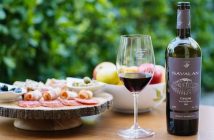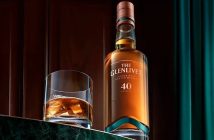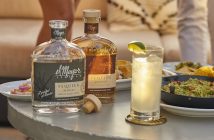On an Indian summer’s day late last year, I gather in the company of some the UK’s top wine journalists in The Green Room on the ground floor of a William and Mary period townhouse. The building is located on one corner of a tranquil inner courtyard just off St James’s Street – a site that in its original format was once also home to part of the medieval maidens’ leper colony of St Stephen’s. On approach to the house as it stands today, the tangible sense of history that exists here is hard to ignore. Victorian black railings frame three stories of white windowpanes, a similarly styled period street-lamp, and a flagpole that bears an iconic golden barrel. This building, since 1792 has been owned by one of the most prestigious wine merchants in Britain, indeed now possibly one of the most prestigious wine merchants in the world: Berry Brothers and Rudd.
In 1698 Berry’s set up shop at Number 3 St James’ and has been influential on leading the way of the world’s wine palate ever since: the company boasts two royal warrants, eight masters of wine, and a much-coveted portfolio of producers whose wines contribute to an overall identity that is comfortably world-class. Today I am here to meet one of their newer producers – Burgundian winemaker Olivier Bernstein, whose first vintage was as recent as 2007.
Over a welcome glass of Berry’s United Kingdom Cuvée Grand Cru Mailly Champagne, our initial chatter revolves around social media – Facebook in particular and if Bernstein, and indeed the rest of us, should opt into it ‘professionally’, how much of ‘you’ you should reveal, and if you name a product or your skill under your name, whether that warrants eyes gazing further in. In our period surrounds, this provides a pause-for-thought moment where ‘Very British Wine Trade’ tradition meets 21st Century modernity through a glass of wine who’s style arguably reflects the very same.
With Olivier, whose family is known more for music publishing than wine, we continue upstairs to where lunch takes place in the Long Room. Olivier hosts us alongside Simon Staples, a Berry Brother’s stalwart and larger than life personality who is over in London briefly from Asia before he returns to head up the Tokyo office in the latest round of Berry’s business shake-ups. Olivier and Simon have spent time together in China, where the market has notable differences to the one we know here at home. There are often stories about Chinese wine buyers tasting wine in ‘shots’ as they come to dine alongside prestigious members of the trade, and indeed the winemakers too – something that must be curious to witness from our own, long-established, more western way of drinking. There are some folk here who will not even try the wine – attending the events for want of prestige alone.
We talk of the infamous fake Bordeaux that come to the Chinese market, often revealed to manifest as what can only be described as very good Australian red blends, likely to have been bottled locally, off-shore. Of course, wine appreciation has to start somewhere, and like many, even Simon admits that he got into wine through drinking WoolfBlass Yellow Label at a time when he thought that all French wine was ‘not very good’. Today it is evident he feels largely very different about what our French cousins offer, championing the work of producers like Bernstein and other grand-cru createurs world-wide.
I’m not sure how we get onto the subject of music and everyone’s individual tastes – perhaps we liken Bernstein’s wine to Mozart, as his background would so fittingly suggest. But it seems that music appreciation within the group is keen – fellow diner Jamie Goode reveals his part of his past as being member of a band known then as Tintagel, whilst Tim Atkin has since taken his own musical turn in the recent Côtes du Rhône Skin Contact gig at Vinopolis in aid of Comic Relief. Simon talks about his own music tastes, and references a time that he once went to New Zealand for 24 hours, just so he could see Bruce Springsteen in concert: as much of a devotee to music, as he is to wine, so it would appear. But as music is a craft that is similarly pleasure-intended, it’s not hard to draw the comparisons.
The banter and other stories amongst us continue, not quite perhaps as vivid as can only have been the case when this building was home to sports such as dog-fighting, bearbaiting, cock-fighting and even bare knuckle boxing in the late 18th century – and our afternoon thankfully did not end, as afternoon’s here once did with a sword duel fought to the death inside the square’s discrete perimeter. Perhaps that might be to come if ever there was to be a battle of the wine-trade’s (re-formed) bands.
We hear of varying curious tales from abroad, as well as discussing Burgundy en generale. This is a region famed the world over for producing some of the best wine known to man. A region the ‘new world’ often looks to emulate, and a style of wine that is usually unmistakable from the very first sip. Burgundy, in recent years, has seen quantities decline and prices rise, thanks in some part to terrible hailstorms that have resulted in substantially damaged fruit on the vines. For regular punters then, this means that with production levels much lower, the wines have achieved an almost ‘luxury product’ status, with buyers often from China or Japan making ‘crafty offers’ for a piece of what Bernstein dubs ‘le village Asterix’. “It’s like buying a piece of the Eiffel Tower.” He makes particular reference to the Maziz-Chambertin, a particularly historic vineyard and AOC (appellation) that is a mere 9hectares big. Olivier owns a tiny, but much sought after 0.2 hectares of this, that he now cites as having a price tag ‘five times higher’.
Like all good Brits, the conversation of the weather and these recent changes progresses to discussion on vintage variation – with Olivier commenting on 2011 – ‘it will be a huge surprise when it shows well’ – referencing the more classic vintages of 2010 and 2012. Of the wines we try over lunch, there are expressions of all three.
Here is a round up of what we tasted:
2010 Puligny-Montrachet Champ-Gain, 1er Cru
A heady white Burgundy that we taste alongside sole ballotine with lobster on cauliflower Polonaise. This is beautifully minerally on the nose, redolent of seashells and pebbles, light flecks of oak and a subtle butteriness underlies the stone fruit that shows itself; restrained. The acidity on this wine is high, prompting waves of tongue tingling saliva and a notable freshness despite the layers of texture. Bright, tropical fruit becomes riper and richer, decorating its golden crown.
2011 Corton-Charlemagne Grand Cru
Wine number two – awash with flavours of subtly sweet grapefruit, a little sea salt and cheesy, citrus rind, but there is also a smoky toastiness to this. It is stunning, with a sublime array of flavours, herbaceous and restrained. Quite the elegant lady. Stunning.
2008 Gevrey-Chambertin, Les Champeaux, 1er Cru
Easing us into our main course of roast saddle of lamb with Niçoise garnish, this is light, with crunchy red fruits and a minerality you can almost lick off the surface of the glass. It is backed up with a meatiness, and perfumed, cedar notes on wet stones, with forest floor and a certain saliva inducing savouriness. Olivier tells us, comparatively, the 2007 is more consistent.
2008 Gevrey-Chambertin Villages
Another 2008: a ‘lower level’ wine from two specific parcels of fruit. This is earthier and more herbaceous than its similarly aged cousin. Approachable and still just as classy.
2010 Chambolle-Musigny Les Lavrottes 1er Cru
A little closed at the moment, still herbaceous and juicy with lots of fruit yet with feminine complexity. The acidity makes your mouth salivate unto the hills. Beautiful. Savoury. Salty.
2011 les Cazetiers 1er Cru
We taste this a little too young. Bernstein says it will be ready in 2-3 years, when it will be drinkable for another 30-40. It is smoky, meaty, minerally. Lovely but young, with charcoal and steel, wet stone. Its fruit although evident, is still hiding…. Despite their youth, this one and the previous are still my favourites of the day.
2009 1er Cru Clos Vogeot
Perfumed and floral, soft and silky smooth with lovely complexity of flavours – both savoury, tertiary and redolent of fresh, primary fruit. It has crunchy violets but is also bloody, more minerally notes.
2002 Chateau de Malle Sauternes
Into a smaller glass arrives a wine that signifies prior completion of our Burgundian foray. This white Bordeaux desert wine swirls around our glasses with thick tears of sweet finesse. It matches to English raspberries with white chocolate tarragon and cookie dough.
The final wine provided a sweet ending to an afternoon of excellent Burgundy, and quality conversation, frequently peppered with rich and personal anecdotes. I’ve always maintained that wine is all about the story, and whether Facebook continues as a platform to convey them or not, long may the practices of both wine and conversation continue to combine.
For more information on Olivier Bernstein’s burgundies, visit www.olivierbernstein.com.
To purchase Olivier Bernstein premiers and grand crus, visit www.bbr.com.




